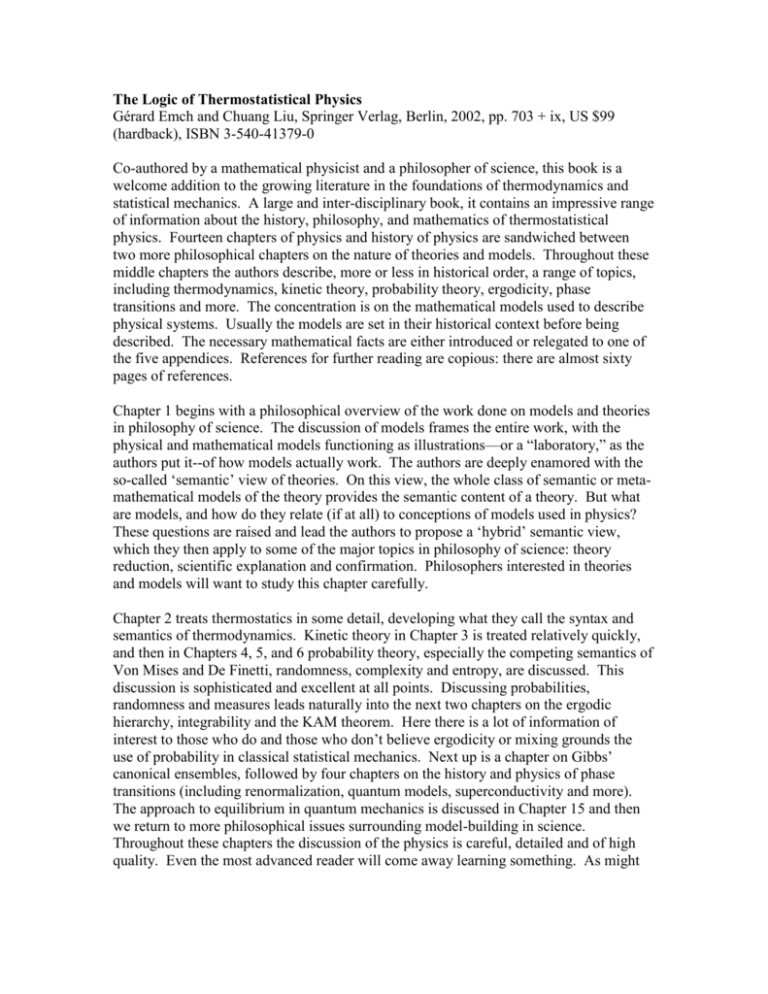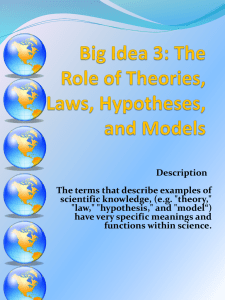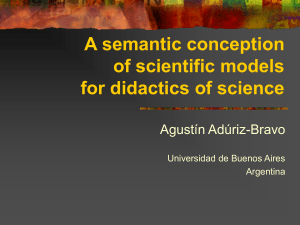The Logic of Thermostatistical Physics
advertisement

The Logic of Thermostatistical Physics Gérard Emch and Chuang Liu, Springer Verlag, Berlin, 2002, pp. 703 + ix, US $99 (hardback), ISBN 3-540-41379-0 Co-authored by a mathematical physicist and a philosopher of science, this book is a welcome addition to the growing literature in the foundations of thermodynamics and statistical mechanics. A large and inter-disciplinary book, it contains an impressive range of information about the history, philosophy, and mathematics of thermostatistical physics. Fourteen chapters of physics and history of physics are sandwiched between two more philosophical chapters on the nature of theories and models. Throughout these middle chapters the authors describe, more or less in historical order, a range of topics, including thermodynamics, kinetic theory, probability theory, ergodicity, phase transitions and more. The concentration is on the mathematical models used to describe physical systems. Usually the models are set in their historical context before being described. The necessary mathematical facts are either introduced or relegated to one of the five appendices. References for further reading are copious: there are almost sixty pages of references. Chapter 1 begins with a philosophical overview of the work done on models and theories in philosophy of science. The discussion of models frames the entire work, with the physical and mathematical models functioning as illustrations—or a “laboratory,” as the authors put it--of how models actually work. The authors are deeply enamored with the so-called ‘semantic’ view of theories. On this view, the whole class of semantic or metamathematical models of the theory provides the semantic content of a theory. But what are models, and how do they relate (if at all) to conceptions of models used in physics? These questions are raised and lead the authors to propose a ‘hybrid’ semantic view, which they then apply to some of the major topics in philosophy of science: theory reduction, scientific explanation and confirmation. Philosophers interested in theories and models will want to study this chapter carefully. Chapter 2 treats thermostatics in some detail, developing what they call the syntax and semantics of thermodynamics. Kinetic theory in Chapter 3 is treated relatively quickly, and then in Chapters 4, 5, and 6 probability theory, especially the competing semantics of Von Mises and De Finetti, randomness, complexity and entropy, are discussed. This discussion is sophisticated and excellent at all points. Discussing probabilities, randomness and measures leads naturally into the next two chapters on the ergodic hierarchy, integrability and the KAM theorem. Here there is a lot of information of interest to those who do and those who don’t believe ergodicity or mixing grounds the use of probability in classical statistical mechanics. Next up is a chapter on Gibbs’ canonical ensembles, followed by four chapters on the history and physics of phase transitions (including renormalization, quantum models, superconductivity and more). The approach to equilibrium in quantum mechanics is discussed in Chapter 15 and then we return to more philosophical issues surrounding model-building in science. Throughout these chapters the discussion of the physics is careful, detailed and of high quality. Even the most advanced reader will come away learning something. As might be expected given chapter 1, throughout there is a stress on the role of various models used in physics. Who are the expected readers of this book? Being so large, it is perhaps no surprise that the book will serve many purposes for many different people. Indeed, to this end the authors provide various different strategies for reading it in the Preface. Though not a textbook in statistical physics, many chapters read like a textbook and could be used for one wanting an advanced introduction to a topic or particular model. If you wish to know, for example, about the Toda lattice model or the KAM theorem, one will find a sophisticated discussion of both: in addition to a careful discussion of the physics, one will find statements of relevant theorems, references to contemporary journal articles on the topic, insightful comments, etc. If you want a worked out version of the canonical Ehrenfest dog-flea model, you will find that too. If you want a detailed mathematical history of the Ising model ‘revolution,’ that will also be found. If you want to see the semantics carefully teased from the syntax of various theories, you can find that here too. In short, with the exception of work on chaos, everything you can think of, and probably many things you can’t, are found in this book. I can therefore imagine this book as useful to physicists wanting more physics, physicists wanting the broader historical, logical and philosophical take on physics, and philosophers and historians of science who want an advanced introduction to some topic or topics in the field. As might be expected given the authors, the mathematical level is often very high. Advanced functional analysis, topology, probability theory and mathematical logic are all used frequently. Some of the Appendices are devoted to explaining the relevant math; there are appendices on logic, the calculus of differentials, recursive functions, and topological essences. The reader should not, of course, think that they will learn these topics from the appendices. Rather, they provide useful theorems and properties that may be needed while reading the book. They place in a handy location information you might otherwise have to look up elsewhere. Regarding the history of thermostatistical physics, there are a number of highlights to mention. Carnot’s argument for an upper limit to the efficiency of a heat engine is richly detailed. The assumptions Carnot used versus the assumptions he needed are teased apart. And throughout Chapter 2 the names of Clausius, Joule, Fourier and others regularly appear, often with fresh and interesting quotes. Other highlights include discussion of the largely ignored finitism of Boltzmann, Clausius on differential forms, von Neumann on von Mises’s foundations of probability, the development of recursive function theory, and the resurgence of mean-field theories with Bose-Einstein condensation. The historical details are not uniformly distributed throughout the book. For instance, after Chapter 2’s rich history of thermodynamics, Chapter 3 very quickly treats the historical context around Boltzmann, Maxwell (the chapter is instead dominated by a fine mathematical treatment of the Boltzmann equation). The history is not meant to be comprehensive, but rather various episodes are placed where they might illuminate the intentions of various model builders. I should say something about what in particular this book addresses for philosophers. The first and most important point I should make is that the main philosophical arguments of the book concern the nature of theories, models, idealization and approximation, not many of the philosophical puzzles in statistical physics. The authors are clear about this, so there is no question of poor advertising. Furthermore, this absence is fair enough, since an attack on these questions is not the goal of the book; but philosophers should know beforehand what they will get and what they will not. If one comes to the book looking for a sustained discussion of many of the philosophical problems discussed in (say) Lawrence Sklar’s Physics and Chance, one may be frustrated. Many of these topics aren’t much discussed. To give an indication, note that of the 700 pages, the Stosszahlansatz, Loschmidt’s objection to Boltzmann, and Zermelo’s objection to Boltzmann each merit only about a paragraph. The battles between ‘Boltzmannians’ and ‘Gibbsians’, between subjectivist and objectivist justifications of the approach to equilibrium, between dynamical and non-dynamical explanations of time’s arrow are not joined. There is a sustained and edifying, but ultimately inconclusive, discussion of the notorious role of ergodicty. There are references to virtually all the recent work in philosophy of statistical mechanics; but one will not find here a developed contribution to most of these debates. What of the main philosophical arguments? There is too much here to discuss in a book review, so I will leave detailed examination to others. However, I would like to comment on the “spirit” of the philosophy. The authors seem to see improved theories of reduction, explanation and confirmation as flowing almost automatically from the switch from the syntactic view to the semantic view: “[t]he semantic view turns the table towards realism, although not completely” (21); [on the semantic view] … it should be obvious that structures are the one responsible for the success or failure of scientific explanations, not the law assertions that describe the relations among their properties” (37). I don’t agree with either of these claims—and I don’t think the authors really do either. All hands agree that the Hempelian HD model and DN models (for instance) are inadequate. But are these essentially tied to the syntactic view? No, for it is perfectly possible for a fan of the syntactic theory to posit some non-Hempelian model of explanation and of confirmation; and it is perfectly possible for a fan of the semantic theory to posit some non-linguistic but Hempelian in spirit model of explanation and of confirmation. Especially once one has a sane syntactic theory, one wherein the linguistic entities are interpreted, the differences between the semantic and syntactic views of theories seem to me mostly technicalia that do not signal a revolution in philosophy of science. It is true that the semantic and syntactic theories are not demonstrably equivalent for non-first order theories (for first-order theories the Completeness Theorem entails equivalence). But I haven’t yet seen an argument that it is this difference that provides connections between the semantic view and realism, reduction, explanation, etc. The connections are psychological and practical, not logical. The semantic view may be a better tool for philosophizing, just as a hammer is better than a screwdriver for knocking in a nail; but choosing a hammer over a screwdriver doesn’t get the nail in. The reason to adopt the semantic view over the syntactic view is that sometimes trying to squeeze a theory of complex phenomena into axiomatic form in first-order language is a very pointless and therefore silly thing to do. Can we axiomatize various theories in biology? While it may be logically possible to do so, it may not be very useful: the list of axioms may be too long to be interesting, axioms stating generalizations may not be both logically strong and simple (i.e., lawlike), and so on. The theory may be too rich and diverse put in a useful syntactic form. By contrast, with certain theories in mathematical physics, for example, it does seem useful to try to axiomatize these theories. The axiomatization might tell us an awful lot about the structure of the theory, its modalities, and its possible equivalences to other theories. Turning to the case in hand, is it pointless or impractical to axiomatize thermodynamics or statistical mechanics? It’s not clear to me that the answer is ‘yes’, especially when I reflect on how much is learned from actual attempts to do so, e.g., by Caratheodory and recently by Lieb and Ygnavson. The authors would be the last to deny this, I suspect, but then I think the superiority of the semantic view for understanding statistical thermophysics is slightly exaggerated. To recap, this book is a tremendously erudite and comprehensive resource in foundations of statistical mechanics. It is also a significant contribution to the philosophical discussion of models and theories. Philosophers will value the application of the semantic view of theories to a wide range of cases in physics. But they will also value the book for the reasons that non-philosophers will: it is a treasure-trove of information. For those doing research in foundations of statistical physics, having this wealth of information in one place will prove invaluable. Craig Callender Philosophy Department, UCSD La Jolla, CA 92093, USA E-mail address: ccallender@ucsd.edu








